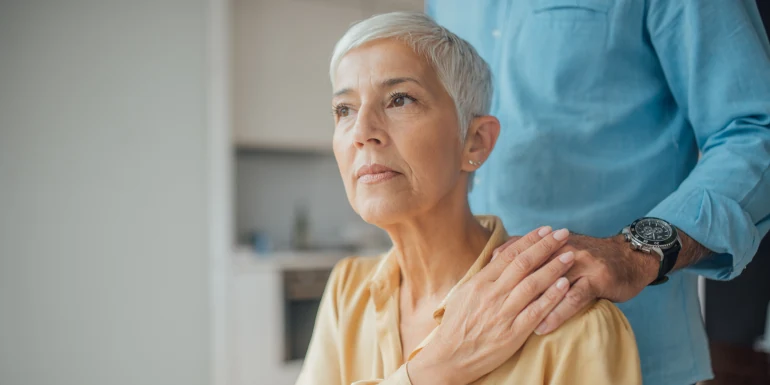
Lung cancer – primarily caused by smoking
Lung cancer is the third most common cancer. It affects 3,500 people every year, the majority of whom are smokers. Passive smoking also increases the risk of lung cancer. If lung cancer is detected and treated early, the patient has a chance of surviving, depending on their general health. The prospects of recovery decrease as the tumour grows.
Symptoms
Signs of early-stage lung cancer that is still treatable are almost always discovered by accident as part of a routine examination or during an examination carried out for other reasons. This is because discomfort is seldom experienced at an early stage. It can therefore be worthwhile for people in at-risk groups* to take part in an early detection programme. Medical advice should always be sought in the event of the following symptoms:
- persistent cough not associated with a cold or fever
- worsening smoker's cough
- coughing blood
- persistent chest pains
- shortness of breath during light activity or when resting
- persistent hoarseness
- frequent, long-lasting colds or lung inflammation
- involuntary weight loss, lack of appetite and general weakness
- frequent high temperature for no apparent reason
- swelling of face and neck
- bone pain
Causes
As with other types of cancer, there is no guaranteed way of preventing lung cancer. In 85% of cases the cause is tobacco smoke. People who smoke are 20 times more likely to get lung cancer. People who are exposed to other people's tobacco smoke over a number of years (second-hand smoke) also have a greater risk of lung cancer.
The second most common cause is breathing in naturally-occurring radon. This is a radioactive gas present in the ground, which can pollute the air in people's homes.
Sometimes, contact with harmful substances such as asbestos, silica dust or particulated air pollution, hydrocarbons and certain chemicals from the work environment can trigger the disease.
Diagnosis
If lung cancer is suspected, the most common course of action is to take tissue samples from the suspected areas of mucous membrane (a process known as a bronchoscopy) and examine them for benign and malignant tumours.
An early diagnosis increases the chances of successful treatment. The low-dose computed tomography (CT) method is particularly suitable for people belonging to a high-risk group*.
*High-risk group: smokers and former smokers between the ages of 55 and 74 with more than 30 pack-years (i.e. who have smoked or still smoke a packet of cigarettes every day for 30 years).
Prognosis
A patient in Switzerland who is discovered to have lung cancer has only a 15% chance of recovery. This is because lung cancer is most often diagnosed at an advanced stage, and so too late for effective action. There is a much better chance of recovery if it is identified very early, i.e. at a stage when it causes no perceptible discomfort.
Prevention
The best form of prevention is to avoid substances that increase the risk of lung cancer, above all tobacco smoke. People who smoke are well-advised to beat their addiction to tobacco and, if they belong to a high-risk group*, to undergo an examination.
*High-risk group: smokers and former smokers between the ages of 55 and 74 with more than 30 pack-years (i.e. who have smoked or still smoke a packet of cigarettes every day for 30 years).
Treatment
Treatment depends on general state of health, the extent of the disease and the type of cancer.
The most favourable outcomes occur in the early stages of the disease, if the tumour can be completely removed or destroyed surgically and has not yet spread. If this is not possible, an attempt is made to slow down the growth of the tumour and to mitigate debilitating symptoms.
Generally, a combination of chemo- and radiation therapy is used for this purpose. For particular subtypes of cancer, targeted biological therapies based on analysis of the tumour genotype have existed for several years.
At the same time, palliative (pain-relieving) treatments are applied to improve the affected person's quality of life. Regular check-ups, rehabilitation using targeted movements and nutrition, along with psychological support, are also extremely important.
Smoking cessation
The most important preventive measure is stopping smoking. Reduce your lung cancer risk with smoking cessation training. The SANA and COMPLETA supplementary insurance policies cover 75% resp. 90% of the costs of trainings.
Smoking cessation
The most important preventive measure is stopping smoking. Reduce your lung cancer risk with smoking cessation training. The SANA and COMPLETA supplementary insurance policies cover 75% resp. 90% of the costs of recognised trainings.
Further information


Newsletter
Find out more about current health issues every month and get all the information you need about our attractive offers from all Helsana Group companies * delivered by e-mail to read whenever it suits you. Our newsletter is free of charge and you can sign up here:
We did not receive your information. Please try again later.
* The Helsana Group comprises Helsana Insurance Company Ltd, Helsana Supplementary Insurances Ltd and Helsana Accidents Ltd.